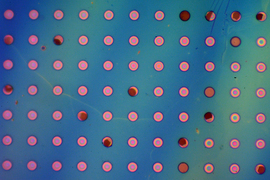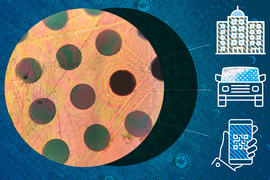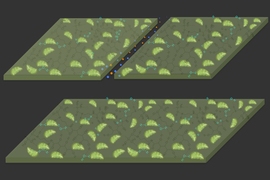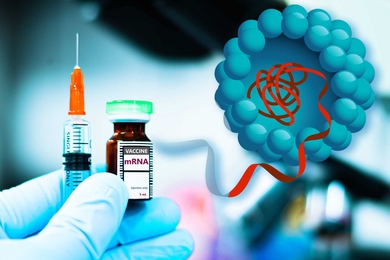MIT researchers have developed a lightweight polymer film that is nearly impenetrable to gas molecules, raising the possibility that it could be used as a protective coating to prevent solar cells and other infrastructure from corrosion, and to slow the aging of packaged food and medicines.
The polymer, which can be applied as a film mere nanometers thick, completely repels nitrogen and other gases, as far as can be detected by laboratory equipment, the researchers found. That degree of impermeability has never been seen before in any polymer, and rivals the impermeability of molecularly-thin crystalline materials such as graphene.
“Our polymer is quite unusual. It’s obviously produced from a solution-phase polymerization reaction, but the product behaves like graphene, which is gas-impermeable because it’s a perfect crystal. However, when you examine this material, one would never confuse it with a perfect crystal,” says Michael Strano, the Carbon P. Dubbs Professor of Chemical Engineering at MIT.
The polymer film, which the researchers describe today in Nature, is made using a process that can be scaled up to large quantities and applied to surfaces much more easily than graphene.
Strano and Scott Bunch, an associate professor of mechanical engineering at Boston University, are the senior authors of the new study. The paper’s lead authors are Cody Ritt, a former MIT postdoc who is now an assistant professor at the University of Colorado at Boulder; Michelle Quien, an MIT graduate student; and Zitang Wei, an MIT research scientist.
Bubbles that don’t collapse
Strano’s lab first reported the novel material — a two-dimensional polymer called a 2D polyaramid that self-assembles into molecular sheets using hydrogen bonds — in 2022. To create such 2D polymer sheets, which had never been done before, the researchers used a building block called melamine, which contains a ring of carbon and nitrogen atoms. Under the right conditions, these monomers can expand in two dimensions, forming nanometer-sized disks. These disks stack on top of each other, held together by hydrogen bonds between the layers, which make the structure very stable and strong.
That polymer, which the researchers call 2DPA-1, is stronger than steel but has only one-sixth the density of steel.
In their 2022 study, the researchers focused on testing the material’s strength, but they also did some preliminary studies of its gas permeability. For those studies, they created “bubbles” out of the films and filled them with gas. With most polymers, such as plastics, gas that is trapped inside will seep out through the material, causing the bubble to deflate quickly.
However, the researchers found that bubbles made of 2DPA-1 did not collapse — in fact, bubbles that they made in 2021 are still inflated. “I was quite surprised initially,” Ritt says. “The behavior of the bubbles didn’t follow what you’d expect for a typical, permeable polymer. This required us to rethink how to properly study and understand molecular transport across this new material.”
“We set up a series of careful experiments to first prove that the material is molecularly impermeable to nitrogen,” Strano says. “It could be considered tedious work. We had to make micro-bubbles of the polymer and fill them with a pure gas like nitrogen, and then wait. We had to repeatedly check over an exceedingly long period of time that they weren’t collapsed, in order to report the record impermeability value.”
Traditional polymers allow gases through because they consist of a tangle of spaghetti-like molecules that are loosely joined together. This leaves tiny gaps between the strands. Gas molecules can seep through these gaps, which is why polymers always have at least some degree of gas permeability.
However, the new 2D polymer is essentially impermeable because of the way that the layers of disks stick to each other.
“The fact that they can pack flat means there’s no volume between the two-dimensional disks, and that’s unusual. With other polymers, there’s still space between the one-dimensional chains, so most polymer films allow at least a little bit of gas to get through,” Strano says.
George Schatz, a professor of chemistry and chemical and biological engineering at Northwestern University, described the results as “remarkable.”
“Normally polymers are reasonably permeable to gases, but the polyaramids reported in this paper are orders of magnitude less permeable to most gases under conditions with industrial relevance,” says Schatz, who was not involved in the study.
A protective coating
In addition to nitrogen, the researchers also exposed the polymer to helium, argon, oxygen, methane, and sulfur hexafluoride. They found that 2DPA-1’s permeability to those gases was at least 1/10,000 that of any other existing polymer. That makes it nearly as impermeable as graphene, which is completely impermeable to gases because of its defect-free crystalline structure.
Scientists have been working on developing graphene coatings as a barrier to prevent corrosion in solar cells and other devices. However, scaling up the creation of graphene films is difficult, in large part because they can’t be simply painted onto surfaces.
“We can only make crystal graphene in very small patches,” Strano says. “A little patch of graphene is molecularly impermeable, but it doesn’t scale. People have tried to paint it on, but graphene does not stick to itself but slides when sheared. Graphene sheets moving past each other are considered almost frictionless.”
On the other hand, the 2DPA-1 polymer sticks easily because of the strong hydrogen bonds between the layered disks. In this paper, the researchers showed that a layer just 60 nanometers thick could extend the lifetime of a perovskite crystal by weeks. Perovskites are materials that hold promise as cheap and lightweight solar cells, but they tend to break down much faster than the silicon solar panels that are now widely used.
A 60-nanometer coating extended the perovskite’s lifetime to about three weeks, but a thicker coating would offer longer protection, the researchers say. The films could also be applied to a variety of other structures.
“Using an impermeable coating such as this one, you could protect infrastructure such as bridges, buildings, rail lines — basically anything outside exposed to the elements. Automotive vehicles, aircraft and ocean vessels could also benefit. Anything that needs to be sheltered from corrosion. The shelf life of food and medications can also be extended using such materials,” Strano says.
The other application demonstrated in this paper is a nanoscale resonator — essentially a tiny drum that vibrates at a particular frequency. Larger resonators, with sizes around 1 millimeter or less, are found in cell phones, where they allow the phone to pick up the frequency bands it uses to transmit and receive signals.
“In this paper, we made the first polymer 2D resonator, which you can do with our material because it’s impermeable and quite strong, like graphene,” Strano says. “Right now, the resonators in your phone and other communications devices are large, but there’s an effort to shrink them using nanotechnology. To make them less than a micron in size would be revolutionary. Cell phones and other devices could be smaller and reduce the power expenditures needed for signal processing.”
Resonators can also be used as sensors to detect very tiny molecules, including gas molecules.
The research was funded, in part, by the Center for Enhanced Nanofluidic Transport-Phase 2, an Energy Frontier Research Center funded by the U.S. Department of Energy Office of Science, as well as the National Science Foundation.
This research was carried out, in part, using MIT.nano’s facilities.











